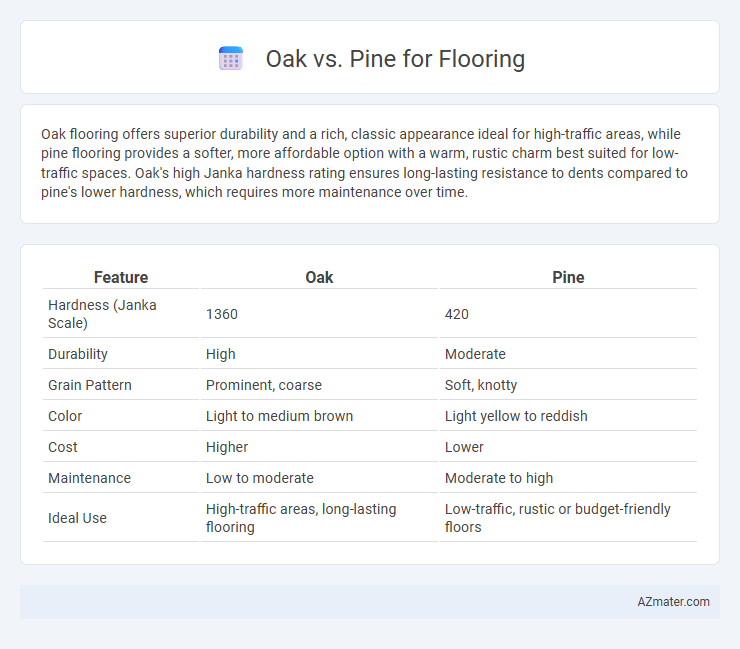Oak flooring offers superior durability and a rich, classic appearance ideal for high-traffic areas, while pine flooring provides a softer, more affordable option with a warm, rustic charm best suited for low-traffic spaces. Oak's high Janka hardness rating ensures long-lasting resistance to dents compared to pine's lower hardness, which requires more maintenance over time.
Table of Comparison
| Feature | Oak | Pine |
|---|---|---|
| Hardness (Janka Scale) | 1360 | 420 |
| Durability | High | Moderate |
| Grain Pattern | Prominent, coarse | Soft, knotty |
| Color | Light to medium brown | Light yellow to reddish |
| Cost | Higher | Lower |
| Maintenance | Low to moderate | Moderate to high |
| Ideal Use | High-traffic areas, long-lasting flooring | Low-traffic, rustic or budget-friendly floors |
Introduction to Oak and Pine Flooring
Oak flooring offers exceptional durability and a classic, timeless appeal with its prominent grain patterns and warm tones, making it a popular choice for high-traffic areas. Pine flooring, known for its softer texture and distinctive knots, provides a rustic charm and affordability, ideal for cozy, casual spaces. Both hardwoods present diverse staining and finishing options, allowing customization to fit various interior design styles.
Key Differences Between Oak and Pine
Oak flooring is renowned for its exceptional durability, hardness rating around 1290 on the Janka scale, and rich grain patterns, making it ideal for high-traffic areas. Pine, with a softer Janka rating near 420, offers a warm, rustic charm but is more prone to dents and scratches, requiring more maintenance in busy spaces. Oak's dense structure and tight grain provide superior resistance to wear and moisture compared to the more porous and reactive nature of pine wood.
Aesthetic Appeal: Grain and Color Variations
Oak flooring features a distinctive grain pattern with prominent rays and flecks, offering a warm, classic look that ranges from light tan to deep reddish-brown hues. Pine flooring showcases a softer, more rustic appeal with visible knots and a lighter, yellowish to amber color palette that ages gracefully over time. Both wood types provide unique aesthetic versatility, making them popular choices depending on whether a homeowner prefers a more traditional or country-style interior design.
Durability and Hardness Comparison
Oak flooring exhibits superior durability and hardness compared to pine, making it ideal for high-traffic areas and long-term wear. Red and white oak have a Janka hardness rating around 1290-1360, whereas pine species typically range from 350 to 870, indicating oak's greater resistance to dents and scratches. The dense grain structure of oak contributes to its strength and longevity, while pine's softer, more porous nature results in easier denting and faster wear over time.
Maintenance and Longevity
Oak flooring offers superior durability and hardness, making it highly resistant to dents and scratches, which reduces maintenance frequency over time compared to pine. Pine floors, being softer and more prone to wear, often require more frequent refinishing and careful maintenance to maintain their appearance. Longevity-wise, oak can last for decades with minimal upkeep, while pine may show signs of aging and damage sooner due to its softer nature.
Cost Analysis: Oak vs Pine Flooring
Oak flooring typically costs between $8 and $15 per square foot, reflecting its durability and premium appearance. Pine flooring is more budget-friendly, averaging $3 to $7 per square foot, but generally requires more maintenance due to its softer nature. Long-term expenses should consider refinishing frequency, with oak needing less frequent refinishing compared to pine, which can increase total lifecycle costs.
Environmental Impact and Sustainability
Oak flooring is typically more sustainable due to its slower growth rate and higher density, resulting in durable planks that require less frequent replacement, which reduces long-term environmental impact. Pine grows faster, making it a more renewable resource, yet it is softer and prone to wear, necessitating more frequent flooring replacements that increase resource consumption. Sustainable forestry practices and certification programs like FSC play a crucial role in minimizing the ecological footprint of both oak and pine flooring materials.
Installation Considerations
Oak flooring offers greater durability and is typically heavier, requiring sturdier subfloor preparation and specialized tools for installation. Pine, being softer and lighter, allows for easier cutting and nailing but may need extra care to prevent dents during installation. Both woods demand precise moisture control to avoid warping, with oak generally tolerating slight fluctuations better than pine.
Suitability for Different Home Styles
Oak flooring offers a versatile, timeless aesthetic that complements traditional, rustic, and modern farmhouse styles with its prominent grain patterns and warm tones. Pine flooring provides a softer, more casual look ideal for cottage, coastal, and country-style homes due to its lighter color and natural knots. Both woods vary in hardness, with oak being more durable for high-traffic areas, while pine adds character through its rustic charm and potential for aging gracefully over time.
Pros and Cons Summary: Oak vs Pine
Oak flooring offers superior hardness and durability, making it highly resistant to dents and scratches, ideal for high-traffic areas. Pine flooring provides a softer, warmer aesthetic with natural knots and grains but is more prone to dents, scratches, and wear over time. Oak requires less maintenance and maintains value better, while pine offers a more affordable, rustic charm but may need refinishing or repairs sooner.

Infographic: Oak vs Pine for Flooring
 azmater.com
azmater.com